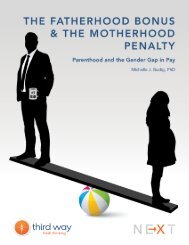6S H O U L D W E L I V E T O G E T H E R ?“. . . cohabitationincreased youngpeople’s acceptanceof divorce, but otherindependent livingexperiences did not.”through a divorce makes one more tolerant of divorce.If the conclusions of these studies hold up under further investigation, theymay contain the answer to the question of why premarital cohabitation shouldeffect the stability of a later marriage.The act of cohabitation generates changes inpeople’s attitudes toward marriage that make the stability of marriage less likely.Society wide, therefore, the growth of cohabitation will tend to further weakenmarriage as an institution.An important caveat must be inserted here.There is a growing understandingamong researchers that different types and life-patterns of cohabitation must bedistinguished clearly from each other. Cohabitation that is an immediate preludeto marriage, or prenuptial cohabitation—both partners plan to marry each otherin the near future—is different from other forms.There is some evidence to supportthe proposition that living together for a short period of time with the personone intends to marry has no adverse effects on the subsequent marriage.Cohabitation in this case appears to be very similar to marriage; it merely takesplace during the engagement period. 11 This proposition would appear to be lesstrue, however, when one or both of the partners has had prior experience withcohabitation, or brings children into the relationship.Cohabitation as an Alternative to MarriageAccording to the latest information available, 46% of all cohabitations in agiven year can be classified as precursors to marriage. 12 Most of theremainder can be considered some form of alternative to marriage,including trial marriages, and their number is increasing.This should be of greatnational concern, not only for what the growth of cohabitation is doing to theinstitution of marriage but for what it is doing, or not doing, for the participantsinvolved. In general, cohabiting relationships tend in many ways to be less satisfactorythan marriage relationships.Except perhaps for the short term prenuptial type of cohabitation, and probablyalso for the post-marriage cohabiting relationships of seniors and retired peoplewho typically cohabit rather than marry for economic reasons, 13 cohabitationand marriage relationships are qualitatively different. Cohabiting couples reportlower levels of happiness, lower levels of sexual exclusivity and sexual satisfaction,and poorer relationships with their parents. 14 One reason is that, as severalsociologists not surprisingly concluded after a careful analysis, in unmarriedcohabitation “levels of certainty about the relationship are lower than in marriage.”15It is easy to understand, therefore, why cohabiting is inherently much less stablethan marriage and why, especially in view of the fact that it is easier to terminate,the break-up rate of cohabitors is far higher than for married partners. After5 to 7 years, 39% of all cohabiting couples have broken their relationship, 40%
S H O U L D W E L I V E T O G E T H E R ?7have married (although the marriage might not have lasted), and only 21% arestill cohabiting. 16Still not fully known by the public at large is the fact that married coupleshave substantial benefits over the unmarried in labor force productivity, physicaland mental health, general happiness, and longevity. 17 There is evidence that thesebenefits are diluted for couples who are not married but merely cohabiting. 18Among the probable reasons for the benefits of marriage, as summarized byUniversity of Chicago demographer Linda Waite, 19 are:• The long-term contract implicit in marriage. This facilitates emotional investmentin the relationship, including the close monitoring of each other’s behavior.The longer time horizon also makes specialization more likely; working as acouple, individuals can develop those skills in which they excel, leaving othersto their partner.• The greater sharing of economic and social resources by married couples. In additionto economies of scale, this enables couples to act as a small insurance poolagainst life uncertainties, reducing each person’s need to protect themselvesfrom unexpected events.• The better connection of married couples to the larger community. This includesother individuals and groups (such as in-laws) as well as social institutionssuch as churches and synagogues.These can be important sources of socialand emotional support and material benefits.In addition to missing out on many of the benefits of marriage, cohabitorsmay face more serious difficulties. Annual rates of depression among cohabitingcouples are more than three times what they are among married couples. 20 Andwomen in cohabiting relationships are more likely than married women to sufferphysical and sexual abuse. Some research has shown that aggression is at leasttwice as common among cohabitors as it is among married partners. 21 Two studies,one in Canada and the other in the United States, found that women incohabiting relationships are about nine times more likely to be killed by theirpartner than are women in marital relationships. 22Again, the selection factor is undoubtedly strong in findings such as these.But the most careful statistical probing suggests that selection is not the only factorat work; the intrinsic nature of the cohabiting relationship also plays a role. Asone scholar summed up the relevant research, “regardless ofmethodology….cohabitors engage in more violence than spouses.” 23“Women incohabitingrelationships aremore likely thanmarried women tosuffer physical andsexual abuse.”



